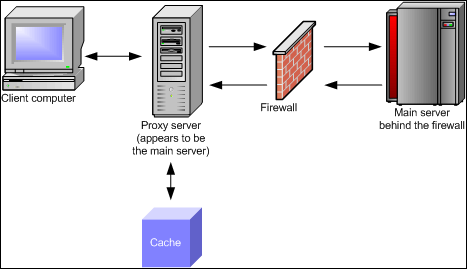| Content Server - Reverse Proxy Server Resource Guide |

|
|
|
|
| Introduction > About Proxy Caching | |
| Content Server - Reverse Proxy Server Resource Guide |

|
|
|
|
| Introduction > About Proxy Caching | |
Proxy caching can provide several benefits to sites that have a large load of web processing requests.
A forward proxy acts as a gateway for a client’s browser, sending HTTP requests on behalf of the client when requests come from the Internet. When a request is processed, the IP address of the proxy is used, rather than the client’s actual address. This hides the IP address of the network from the outside world.
A reverse proxy server issues requests on behalf of the backend HTTP server, not on behalf of the client. Because of this, a client configuration is not needed. Clients access the server as if it were a regular web site. A reverse proxy server acts as a gateway to an HTTP server, and is the final IP address for requests from the outside.
In addition to this protective feature, a proxy cache stores documents close to the user, thus eliminating wait time for retrieval. The client web browser is configured to send all requests to the proxy server. The proxy server, located close to the client, caches the web content, thus providing faster access to common sites and pages. Caching proxy servers reduce traffic from the local site to the Internet, saving valuable bandwidth and reducing connection costs.
A reverse proxy server can also cache requests that it serves from the backend server. When a request is received for a page, the reverse proxy server forwards the request to the backend server and caches the page in addition to returning the page to the client. Subsequent requests to that page can be served from the cache, as long as the cache hasn’t expired.
The following illustration shows how a reverse proxy server ‘hides’ the identity of the main server from those systems which are making requests.
Reverse proxy and main server identity

The firewall is configured to allow a specific server on a specific port to have access to the secure server. When a client makes a request, the request goes through the proxy server, which passes the request through the firewall to the secure server. A result is passed back through the firewall to the proxy.
If an error is returned, the proxy server intercepts the message and changes the URLs listed in the headers before sending the message on to the client. In this way, external clients do not receive redirection to URLs to the secure server.
Multiple proxy servers can be used for load-balancing by taking advantage of the caching features of the proxy server. If you have a web server that has active traffic, proxy servers can take some of the load from the web server, making network access more efficient. After an initial starting period (in which the proxy servers retrieve documents for the first time), the number of requests to the actual web server will drop as the proxy server cache is used instead.
|
|
|
Copyright © 1996, 2007, Oracle. All rights reserved. |